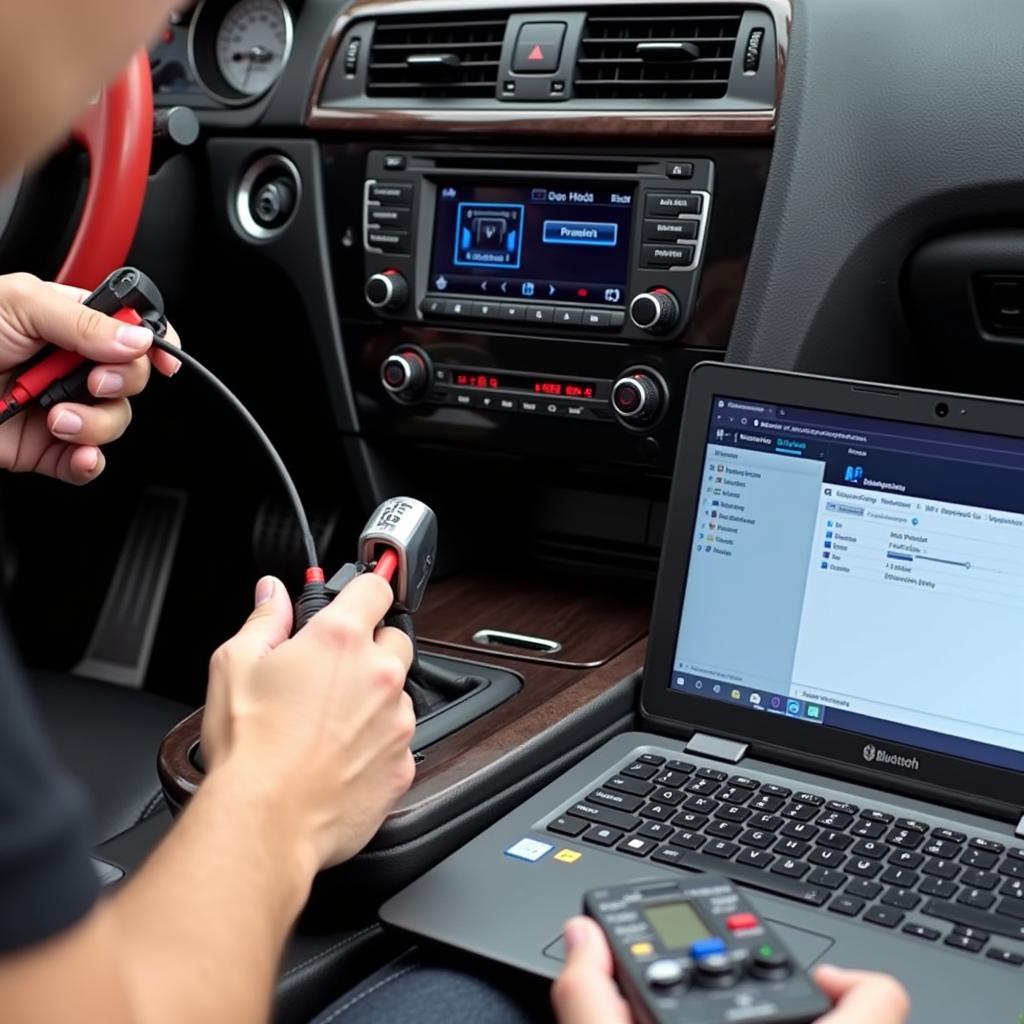The BMW i4 reverse sound is a crucial safety feature designed to alert pedestrians and other vehicles of your presence when reversing. This article dives into the intricacies of the i4’s reverse sound system, addressing common issues and providing solutions for troubleshooting.
Decoding the BMW i4’s Reverse Sound System
The BMW i4, being an electric vehicle, doesn’t have a traditional engine noise to signal its movement at low speeds. To compensate for this, it utilizes an Acoustic Vehicle Alerting System (AVAS) which produces a distinctive sound when reversing. This sound is projected externally, ensuring those around the vehicle are aware of its maneuver. The AVAS is automatically activated when the i4 is in reverse and below a certain speed. This system is not just a BMW feature; it’s a legal requirement for electric vehicles in many countries to enhance pedestrian safety. This crucial system plays a vital role in navigating parking lots, driveways, and other areas with limited visibility.
Common BMW i4 Reverse Sound Problems
While the i4’s reverse sound system is generally reliable, several issues can arise. Some drivers have reported the sound being too quiet, too loud, intermittent, or even completely absent. These issues can stem from various factors, including software glitches, speaker malfunctions, or wiring problems. Understanding these potential causes is the first step toward effectively troubleshooting the system. Ignoring these issues could compromise safety, making it essential to address them promptly.
Troubleshooting a Faulty Reverse Sound
If you experience problems with your i4’s reverse sound, there are a few troubleshooting steps you can take. First, check the iDrive system settings to ensure the AVAS is enabled and the volume is set appropriately. If the issue persists, try restarting the vehicle. Sometimes, a simple reboot can resolve minor software glitches affecting the system. If these initial steps don’t resolve the problem, further diagnosis with specialized diagnostic tools may be necessary.
The Role of Software in the i4’s Reverse Sound
The BMW i4’s reverse sound is controlled by software, making software updates critical for maintaining optimal performance. These updates can address bugs, improve sound quality, and even introduce new functionalities. It’s crucial to keep your i4’s software up-to-date to ensure the reverse sound system functions reliably and effectively. Regularly checking for and installing software updates can prevent many potential issues.
Advanced Diagnostics and Remote Software Solutions
For complex issues that basic troubleshooting can’t resolve, advanced diagnostics and remote software solutions are available. These solutions allow technicians to access the vehicle’s systems remotely, diagnose problems, and even install software updates or reprogram modules without physical access to the car. This can significantly reduce downtime and offer a more convenient and efficient way to address complex technical issues.
Why Choose Professional Assistance for Reverse Sound Issues?
While some troubleshooting steps can be performed independently, seeking professional assistance is often recommended, especially for complex issues. Qualified technicians possess the necessary expertise, tools, and access to the latest software updates to diagnose and resolve problems efficiently and effectively. Trying to fix complex issues without the proper knowledge and equipment could lead to further damage or compromise the vehicle’s safety systems.
“Regular software updates are essential for maintaining the optimal performance of your i4’s reverse sound system. Don’t overlook these updates, as they often contain crucial fixes and improvements.” – John Miller, Automotive Electrical Engineer at CARDIAGTECH
BMW i4 Reverse Sound: Ensuring Safety and Compliance
The BMW i4’s reverse sound isn’t merely a feature; it’s a vital safety component. It ensures compliance with regulations and protects pedestrians and other road users. Understanding its operation, potential issues, and troubleshooting options is crucial for every i4 owner.
“Addressing reverse sound issues promptly is crucial for maintaining safety and avoiding potential accidents. Don’t hesitate to seek professional help if you encounter any problems.” – Sarah Davis, Senior Diagnostics Technician at CARDIAGTECH
In conclusion, the BMW i4 reverse sound is a critical safety feature that requires attention and maintenance. By understanding its functionality and taking proactive steps for troubleshooting and maintenance, you can ensure optimal performance and enhance safety for yourself and others.
FAQ
- Why is my BMW i4 reverse sound not working? Several factors can cause this, including software glitches, speaker malfunctions, or wiring issues.
- How do I adjust the volume of the reverse sound? The volume can usually be adjusted through the iDrive system settings.
- Are there any software updates for the reverse sound system? Yes, BMW regularly releases software updates that can improve the system’s performance.
- Should I seek professional help for reverse sound issues? While some issues can be resolved with basic troubleshooting, seeking professional assistance is recommended for complex problems.
- Is the reverse sound a legal requirement? Yes, in many regions, it’s a legal requirement for electric vehicles to have an AVAS.
- What is AVAS? AVAS stands for Acoustic Vehicle Alerting System.
- How do I know if my i4’s AVAS is functioning correctly? You should hear a distinct sound when the vehicle is in reverse and below a certain speed.
Need further assistance? Contact us via Whatsapp: +1 (641) 206-8880, Email: [email protected] or visit us at 276 Reock St, City of Orange, NJ 07050, United States. Our customer service team is available 24/7. We also offer other services related to BMW diagnostics and programming. Check out our other articles on CARDIAGTECH for more information about your BMW i4.


